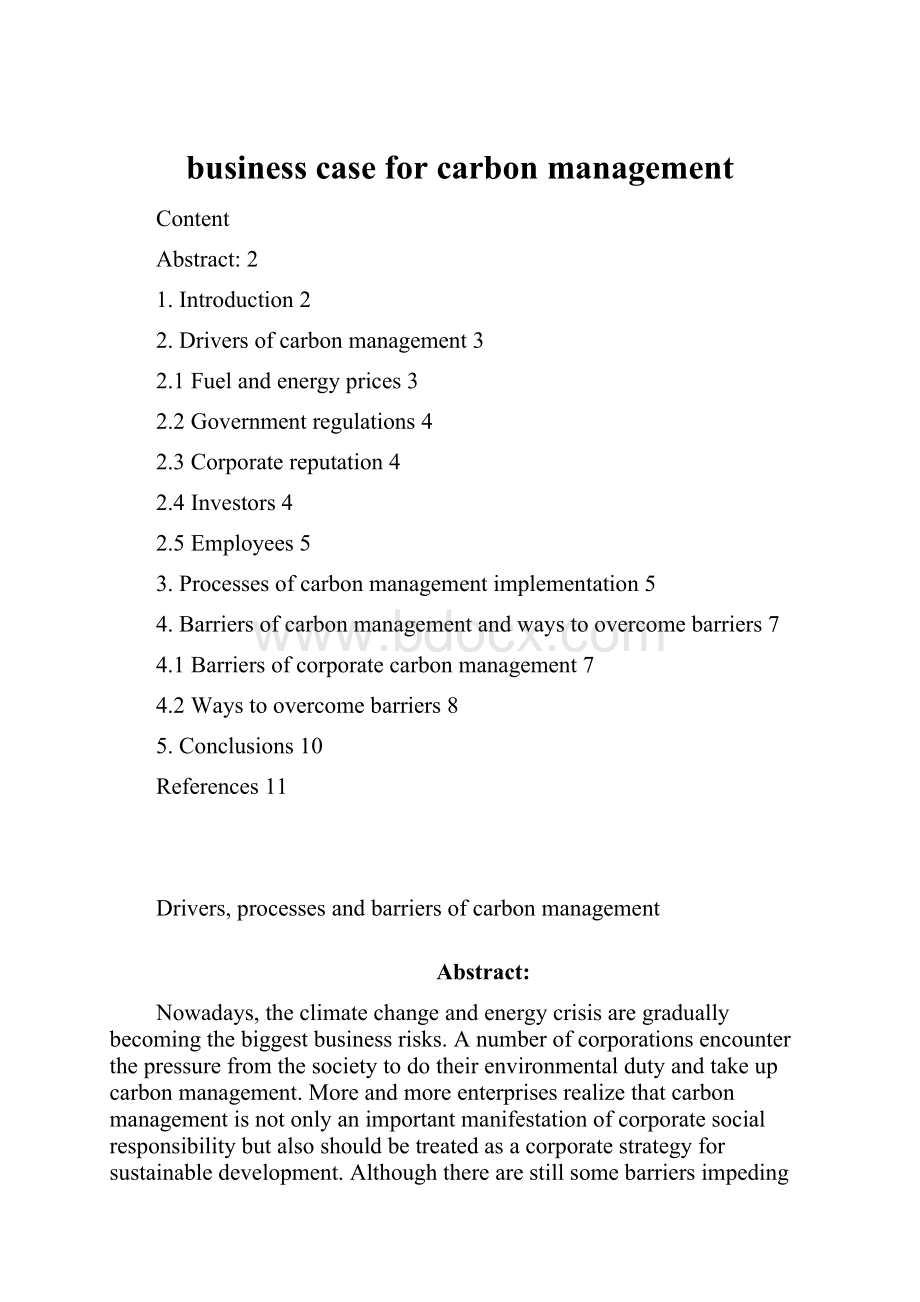business case for carbon management.docx
《business case for carbon management.docx》由会员分享,可在线阅读,更多相关《business case for carbon management.docx(9页珍藏版)》请在冰豆网上搜索。

businesscaseforcarbonmanagement
Content
Abstract:
2
1.Introduction2
2.Driversofcarbonmanagement3
2.1Fuelandenergyprices3
2.2Governmentregulations4
2.3Corporatereputation4
2.4Investors4
2.5Employees5
3.Processesofcarbonmanagementimplementation5
4.Barriersofcarbonmanagementandwaystoovercomebarriers7
4.1Barriersofcorporatecarbonmanagement7
4.2Waystoovercomebarriers8
5.Conclusions10
References11
Drivers,processesandbarriersofcarbonmanagement
Abstract:
Nowadays,theclimatechangeandenergycrisisaregraduallybecomingthebiggestbusinessrisks.Anumberofcorporationsencounterthepressurefromthesocietytodotheirenvironmentaldutyandtakeupcarbonmanagement.Moreandmoreenterprisesrealizethatcarbonmanagementisnotonlyanimportantmanifestationofcorporatesocialresponsibilitybutalsoshouldbetreatedasacorporatestrategyforsustainabledevelopment.Althoughtherearestillsomebarriersimpedingcarbonmanagementimplementation,itcannolongerstopdevelopingcorporatecarbonmanagement.Thisarticlefirstproposesthenecessityofundertakingcarbonmanagementforcompaniesthroughanalysingthedriversofcarbonmanagementwhichcanhelpcompanytotransformpotentialrisksintobusinessopportunities.Then,itbrieflypresentsthestagesofcarbonmanagementimplementation.Next,itliststhebarrierswhichhindercarbonmanagementimplementation.Finally,itsuggestsseveralwaystoovercomebarriersinordertoencouragecorporatecarbonmanagementandimprovecorporatelong-termdevelopment.
1.Introduction
Carbonmanagementisamajorpartofenvironmentalinitiativesinrecentyears.AsshowninBusinessInsight(2010)thenatureofcarbonmanagementisthemanagementofgreenhousegasessincethemajorcontributorofgreenhousegasestoclimatechangeiscarbondioxide.Themainfocusofcarbonmanagementisemission-reductionandenergy-saving.
Itcanbeseenthatmassivegreenhousegasesfromhumanactivitiesalreadyhasnegativeimpactsonenvironment,thus,thefirmsshouldundertakeenvironmentalresponsibilitywhichisamainpartofcorporatesocialresponsibilitythroughcarbonmanagement(Clapp,2005).Moreover,accordingtoLeeandBeresford(2010),carbonmanagementshouldbetreatedmorethancorporatesocialresponsibilityissue,italsoshouldbeconsideredasacorporatestrategybecauseofthefinancialandreputationalriskpresentedbycarbonregulationsandthestrongrelationshipbetweenemission-reductionandenergycosts.
Firstofall,thispapergivesfivedriversofcarbonmanagementwhichembodytheimportanceofcarbonmanagementimplementation.Secondly,itpointsoutthethreeprocessesofcarbonmanagementprogrammeimplementation.Afterthatthearticlediscussesseveralbarrierstocorporatecarbonmanagement.Atlast,itindentifiesthesolutiontothebarriersothatcarbonmanagementwillbeimplementedmoresmoothly.
2.Driversofcarbonmanagement
2.1Fuelandenergyprices
Thefirstfactorthathasthepotentialtoimpelfirmstoundertakecarbonmanagementisfuelandenergyprices.Itisknownthatfuelandenergyaretheinimitablelifebloodofindustrialeconomy,meanwhile,alargenumberofbusinessoperationsintimatelydependonfuelandenergyconsumption.AccordingtoArnbergandBjorner(2007),fuelandenergyrelatedexpenditureoccupiesalargepercentageofcorporateannualregularspending.Whenthefuelandenergypricesgoup,corporatecapitalexpenditurewillincreaseandprofitswillbereducedaccordingly.ItisalsopointedoutbyLeeandBeresford(2010)thatthefuelandenergypricevolatilityplaysanimportantroleindrivingcarbonmanagement.Thus,itisessentialforcompaniestoundertakecarbonmanagementsothattheycanachievecostsaving.
2.2Governmentregulations
Aseconddriverforcorporatecarbonmanagementisgovernmentregulations.Regulationsfromnationsandgovernmentsdirectlyurgecompaniestoundertakecarbonmanagement.Forinstance,carbontaxeswillresultinhigherfuelandenergycostswhicharerelatedtothefirstdriversothatcompaniesshouldtakeclimatestrategy.Moreover,asitisshownbyOkereke(2007),nearlyallthereportsprovidedbyUKFTSE100corporationsstatethatthecurrentandfuturegovernmentregulationsareacrucialdriverofcorporateactionstoclimatechange.
2.3Corporatereputation
Athirdandapparentdriveriscorporatereputation.ItispointedoutbyLingietal.(2010)thatcompanieshaveopportunitiestoenhancecorporateimagethroughtakingactiontoreducetheirgreenhousegasemissions.Agoodreputationisacrucialstrategicassetwhichcanencouragecompanybuildingandattractmorecustomers.Moreover,accordingtoGalbreath’s(2010),corporatesocialresponsibilitywillsendsigntostakeholdersapositiveviewofcorporatebehaviourtherebyimprovingcorporateimage.Carbonmanagementasasignofcorporatesocialresponsibilityhaspositiveinfluenceoncorporatereputationaccordingly.Therefore,companiesshouldundertakecarbonmanagementtoimprovetheirlong-termdevelopment.
2.4Investors
Thefourthdriverisinvestors.Inrecentyears,investorsaregraduallyawareofclimatechangerisksexposure.Theyaskfirmstodiscloseinformationthroughprojectssuchascarbondisclosureproject.AccordingtoCarbonDisclosureProject(CDP2010),theresponseratewashighat82%whichclearlyshowedthatinvestors’awarenesshadimprovedcomparedtoearlieryears.Atthesametime,CDPhadmobilized534investorswithassetsofUS$64trilliontopressurecorporationsattheendof2010.Asaresult,duetohigherinvestors’concernaboutclimatechangerisk,itisusefulforcompaniestoundertakecarbonmanagementprogramtoattractmorenewinvestors.
2.5Employees
Withregardtothefifthdrivers,employeesshouldnotbeignored.Recently,companieswhichhavepoorrecordsonclimatechangeactionencountermoreandmorechallengestorecruitnewemployees.Theyareafflictedmoreemployeeturnoverduetoemployeediscontentwithcorporatefailuretotakeclimatechangeactionandhigheremployeecostsasaresultoflowerproductivity.Hence,companiesshouldtakeclimatestrategiesthroughestablishingsustainableprogramsormotivatingemployeeinnovationwithclimatechangeactivities.
3.Processesofcarbonmanagementimplementation
Theimplementationofcarbonmanagementisalwaysdividedintothreeprocesses:
carbondisclosurestage,carbonreductionstageandcarbonneutralstage.
Incarbondisclosurestage,companiesshouldfocusonestablishingagreenhousegasemissionsinventory.Tobemoreprecise,companiesshouldcollectandprovideinformationaboutcorporatecarbonemissionswhichisthedatabasisoffuturecarbonmanagementactivities.Inaddition,carbondisclosureincludesinformationonanextensiverangeofclimate-relatedactions,suchasmeasurementofgreenhousegasemissions,organizationalpreparations,technologicalinvestments,andsoon(Kolk,Levy&Pinkse2008).Meanwhile,companiesshouldalsoprovidemorespecificbutnarrowerinformationfortheinstanceofcorporategreenhousegasaccountingandreporting.Thecarbonaccountingandreportingshouldcomplywiththeprinciplessuchastransparencyandaccuracy(WBCSD&WRI2004).Moreover,companiesshouldvoluntarilydisclosetheircarbonemissiontopublicinordertoacceptexternalsupervision.
Withregardtocarbonreductionstage,itisthemostcrucialpartofcompanies’carbonmanagementprogram.Itisimpossibletoresolvetheproblemcausedbyclimatechangewithoutthisprocess.Throughgreenhousegasreduction,companiescannotonlydecreasetheirownclimateimpactbutalsoenablethemselvestorecognisethepotentialbenefits.
Turningtocarbonneutralstage,themainfeatureofitisreducingcompanies’overallclimateimpacttozerothroughcarbonoffsets.Itenablestherecoursesofcarbonmanagementtobeallocatedrationally.
Inthecurrentandfuturestandards,someareservingtowholecarbonmanagementprocess.Firstly,ISO14064-1rendersaservicetocorporatedisclosure.Moreover,PAS2050,ISO14067andstandardsofLifeCycleAnalysisISO14040/14044servetostage2–carbonreductionstage.Furthermore,ISO14064-2andPAS2060whichwasrealisednotlongagoareservingtocarbonneutralstage.Thus,whencorporationswanttoundertakecarbonmanagementprogrammes,itisessentialforcompaniestounderstandtheabovestandardstoensuretheeffectiveimplementationofcarbonmanagement.
4.Barriersofcarbonmanagementandwaystoovercomebarriers
4.1Barriersofcorporatecarbonmanagement
Thefirstbarrieristhatsomecompaniesstillnotclearlyrecognisethevalueandimplicationofgreenhousegasmanagement.Althoughsomecompaniesrealizedthatgreenhousegasmanagementprogrammecanenablethemtomeettheneedsofcustomersandrequirementsofgovernmentdepartmentsandsustaingoodimageofactivelyundertakingcorporatesocialresponsibility,theyhavenotunderstandtheimportantvalueofcorporateinternalemission-reductionandenergy-saving.
Thesecondbarrieristhatcorporationsarelackofplantoprepareagreenhousegasemissionsinventory.Therearestillmanycorporationsallocatingtheiroperatingscheduleaccordingtocustomer’srequirement.However,thisbehaviourmaycausesomeproblemswhenbeappliedingreenhousegasinventoryreporting.Thisisbecauseperforminggreenhousegasinventoryshouldbebasedonalargenumberoforiginallyresponsiblestatistics.Thesedatashouldalwaysbecollected,retainedandgatheredconsciously,thus,companiesshouldestablishagreenhousegasinventoryteam(Leering2010).However,itwilltakealongtimetocreateacomprehensivegreenh